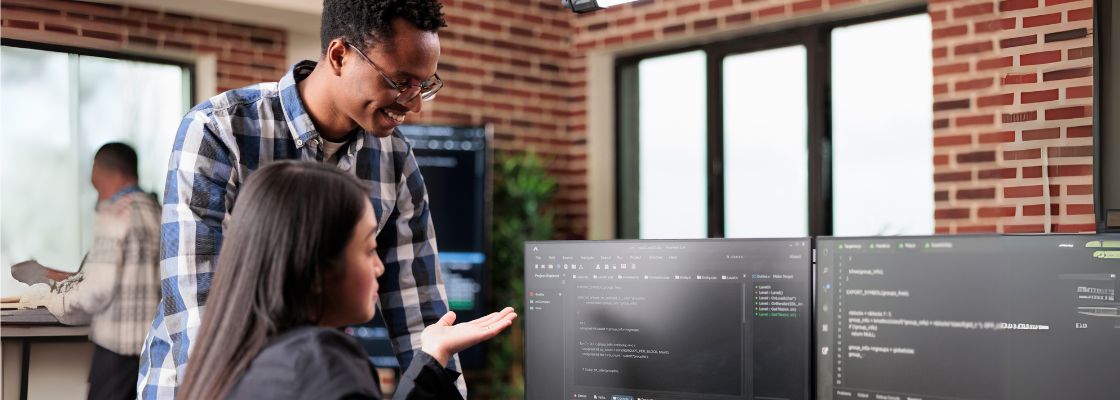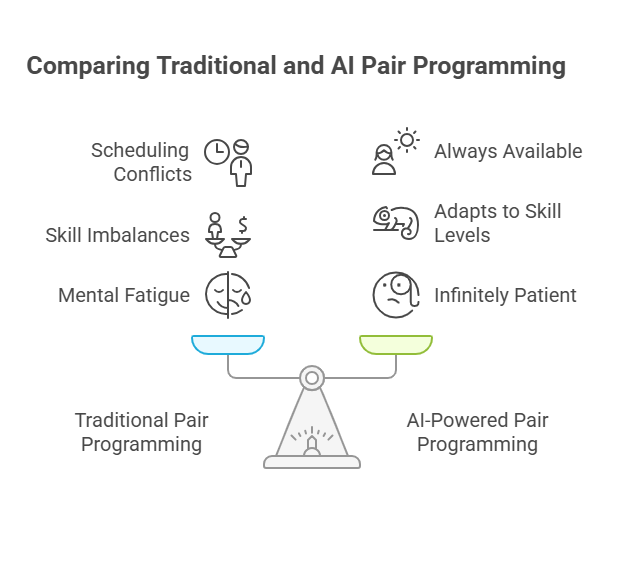AI Co-Developers: How LLMs Are Transforming Pair Programming

Picture this: You’re in the middle of a complex coding session, and your pair programming partner is just as focused and knowledgeable as they were when you started hours ago. No mental fatigue, no need to step away for a break, and they remember every detail from your earlier discussion about that tricky algorithm.
This isn’t science fiction—it’s the reality of AI-powered pair programming.
For decades, software development and pair programming have been inseparable, with two developers working together at a single workstation—one “driving” the code while the other “navigates” through design and review. While this practice has proven invaluable for reducing bugs and improving code quality, it comes with distinctly human limitations: scheduling conflicts, energy dips, and those inevitable off days.
Enter the era of AI co-developers, where Large Language Models (LLMs) are rewriting the rules of collaboration and transforming the very landscape of software development.
LLMs like GitHub Copilot, Amazon CodeWhisperer, and ChatGPT are revolutionizing how developers approach their craft. These AI systems can understand natural language, comprehend code context, and generate sophisticated solutions in real-time. What we’re witnessing is not just an evolution of tools, but a fundamental transformation in the pair programming paradigm—from human-human collaboration to human-AI collaboration. LLMs are reshaping software development by acting as intelligent, always-available co-developers that bring unique capabilities to the coding process while maintaining the collaborative spirit that makes pair programming so effective.
From XP to LLMs: The Evolution of Pair Programming
Traditional pair programming emerged from the Extreme Programming (XP) methodology, establishing clear roles where the driver focuses on writing code while the navigator thinks strategically about design, potential issues, and overall architecture. This approach has delivered significant benefits including fewer bugs, enhanced knowledge sharing between team members, and improved design thinking through continuous dialogue and review.
The collaborative nature of pair programming naturally leads to higher code quality as two minds work together to solve problems, catch errors early, and consider multiple approaches. Teams practicing pair programming often report better onboarding experiences for new developers and more robust, maintainable codebases.
However, traditional pair programming faces practical limitations that have prevented its widespread adoption. Scheduling conflicts arise when two developers need to coordinate their time, skill imbalances can create frustration or inefficiency, and mental fatigue from intense collaboration can reduce productivity over extended sessions. These challenges create natural entry points for LLMs as coding partners that are always available, infinitely patient, and capable of adapting to different skill levels and working styles.

Intelligent Assistants: How LLMs Act as Co-Developers
Modern LLMs function as sophisticated coding assistants by leveraging their training on vast repositories of code, documentation, and programming best practices. AI tools for pair programming like GitHub Copilot integrate directly into development environments, providing real-time suggestions and completions, while ChatGPT and similar models offer conversational interfaces for more complex problem-solving and code analysis.
The strength of LLMs lies in their ability to understand both natural language and code context simultaneously. Using large language models for coding support, developers can describe problems in plain English and receive functional code snippets, or provide existing code and get suggestions for improvements, refactoring, or extensions. These AI co-developers excel at various tasks that traditionally require significant developer time and effort:
- Code generation: Transform plain-English descriptions into functional code snippets and boilerplate templates
- Real-time suggestions: Provide intelligent autocomplete that goes beyond syntax to suggest entire functions based on context
- Refactoring assistance: Analyze existing code and suggest improvements in logic, naming conventions, and structure
- Test creation: Generate comprehensive test suites, identify edge cases, and create relevant test data
Tangible Benefits: Real-World Impact of AI Pair Programming
The practical applications of co-programming with LLMs are already transforming how organizations approach software development:
- Faster Prototyping: Convert plain-English problem statements into working code scaffolds within minutes, allowing teams to explore multiple approaches quickly and validate concepts before detailed implementation
- Improving code quality with LLMs: Provide inline suggestions for better naming conventions, identify potential bugs before production, and suggest refactoring opportunities that improve maintainability while enforcing coding standards consistently across teams
- Documentation Support: Automatically generate docstrings, inline comments, and comprehensive README files that stay current with code changes, addressing one of the most commonly neglected aspects of software development
- Onboarding and Mentorship: Serve as contextual tutors for junior developers, providing explanations for complex code, helping understand error messages, and guiding learning about unfamiliar frameworks. This demonstrates how developers use AI assistants in coding to accelerate the onboarding process
- Legacy Code Modernization: Assist in translating outdated codebases to modern frameworks and languages, as demonstrated by Morgan Stanley’s DevGen.AI tool, potentially saving thousands of developer hours while reducing manual translation risks
Real-world success stories include GitHub CEO Thomas Dohmke’s emphasis that AI tools enable developers to reach a “magical flow state” by handling mundane tasks, allowing greater focus on creative problem-solving and architectural decisions.
Know the Limits: Challenges That Still Require Human Judgment
Despite their impressive capabilities, LLMs as co-developers face several significant limitations that require careful consideration and human oversight:
- Context limitations: While LLMs excel at understanding local code context, they often miss broader architectural implications that experienced developers naturally consider, potentially leading to solutions that work locally but create integration problems
- Security and privacy concerns: Code suggestions may inadvertently expose training data patterns, and questions arise about code ownership when AI systems contribute significantly to development, requiring clear governance frameworks
- Overreliance risk: Developers who become too dependent on LLM suggestions may experience skill atrophy in critical areas like debugging, algorithmic thinking, and system design
- Bias and hallucinations: LLMs can generate incorrect or outdated code suggestions, perpetuate training data biases, or confidently suggest solutions that appear correct but contain fundamental flaws
Addressing these limitations requires ongoing human oversight, robust testing practices, and continuous model improvement through feedback and retraining.

Looking Ahead: The Future of Human-AI Collaboration in Software
The future of development lies not in replacing human developers, but in enhancing their capabilities through intelligent collaboration with AI. LLMs are reshaping developer roles, moving the focus from routine coding tasks to higher-order thinking.
Key Shifts in Developer Responsibilities:
- Transitioning from writing boilerplate code to defining smarter problem statements
- Focusing on architectural decisions and creative problem-solving
- Leveraging AI to accelerate ideation and implementation
This evolution fosters a culture of continuous learning, where developers enhance their skills to work effectively alongside AI partners. Success now depends on the ability to:
- Craft clear, contextual prompts
- Critically validate AI-generated code
- Maintain strong fundamentals in design and debugging
Emerging Dynamics in Human-AI Feedback Loops:
- AI learns from developer preferences and coding styles
- Developers improve communication and efficiency with AI assistants
Looking ahead, personalized LLMs trained on proprietary codebases present a powerful advantage. These tailored models can:
- Recognize company-specific coding patterns and domain rules
- Offer context-aware, precise recommendations aligned with business needs
As noted by The Guardian, this shift is already transforming how computer science is taught—prioritizing problem-solving and design over syntax memorization.
A New Era of Software Engineering Begins
LLMs are fundamentally reshaping the pair programming model by introducing AI co-developers that combine the benefits of collaborative coding with the advantages of always-available, adaptive assistance. These tools are accelerating development cycles, improving code quality, and democratizing access to programming expertise while creating new paradigms for how developers learn and work together.
The key to success in this new landscape lies in striking the right balance between AI efficiency and human creativity, ensuring that developers remain engaged, skilled, and capable of independent critical thinking while leveraging the remarkable capabilities that LLMs bring to the coding process.
Organizations and individual developers who embrace this AI co-developer model with a responsible, forward-thinking mindset will find themselves at the forefront of the next generation of software development practices.
As we move forward, the question isn’t whether AI will change how we develop software—it’s how quickly we can adapt to work effectively with these powerful new partners while maintaining the human insight, creativity, and judgment that remain irreplaceable in creating truly innovative solutions.
At V2Solutions, we harness AI-driven pair programming to accelerate development, improve code quality, and enhance developer productivity. By integrating LLMs into our workflows, our teams build scalable, secure, and innovative solutions—while keeping human creativity and oversight at the core.
Connect with us to explore how AI co-development can elevate your software initiatives.